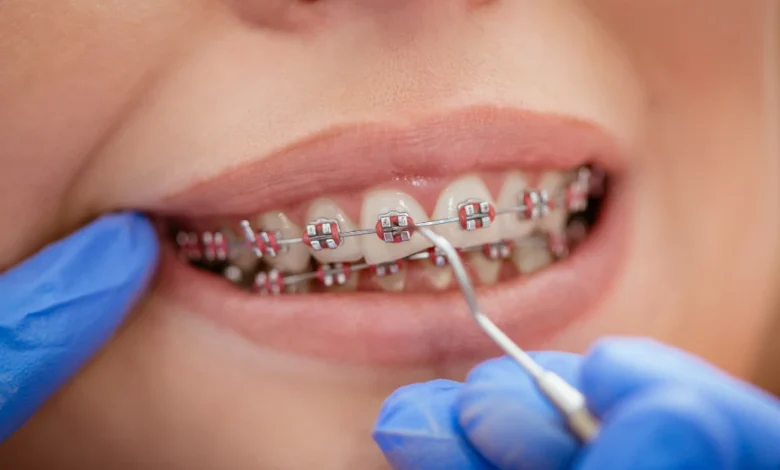Braces and Gum Swelling: Simple Ways to Treat and Prevent It(need to be changed)

Getting braces can help you get a beautiful and shiny smile to boost confidence. No doubt taking the decision to take braces might be difficult due to some side effects. One of the most common issues you may deal with is gum swelling. If your gums feel sore or puffy or look red after getting braces, you’re not alone.
In this blog, we’ll explain the common reasons behind braces and gum swelling, how to treat it at home, and the best ways to prevent it from happening again.
Why do gums swell with braces?
Let’s start with the basics. When you get braces, they slowly move your teeth to the right position. Obviously this pressure makes you uncomfortable and causes irritation, but it’s good for your smile. So be motivated for your future’s beautiful smile. Here we are sharing with you a few common causes of gum swelling during orthodontic treatment. Let’s explore:
1. Tooth movement
The main reason your gums swell after getting braces treatment is that your teeth are being shifted into the right position. Braces work by softly and gently driving your teeth into the appropriate place. With time, teeth move, and your jawbone and gums alter also. As a result, it makes your gums feel sore or swollen. This is a normal part of getting braces, especially when they’re first put on or after an adjustment.
2. Gingivitis (primary gum disease)
Braces make more small spaces in your mouth where food can get stuck. If you don’t clean your teeth from plaque and foods properly, it may lead you to inflamed and infected gums. This is an early stage of gum disease also called gingivitis. Gingivitis may lead you to red, swollen, and sometime bleeding gums
3. Gingival hyperplasia (Overgrowth of gums)
Sometimes, the irritation from braces and trapped plaque can cause your gums to grow too much. This is called gingival hyperplasia. It’s not dangerous in most cases, but it can make brushing and flossing harder. Usually, the gum tissue returns to normal after your braces come off, but in rare cases, a dentist may suggest gum trimming.
4. Gum disease (If not treated)
If gingivitis is not taken care of, it can lead to a more severe form of gum disease. When this happens, bacteria can damage the tissues that support your teeth. Due to braces brushing and flossing may be difficult eventually it will elevate the risks of gum and infection problems.
Symptoms of gum swelling with braces
Here we are sharing signs that are the reasons of gum swelling due to braces placement. Lt’s have a look.
Bad breath
Bleeding when brushing or flossing
Gums growing over the brackets
Soreness or discomfort
Note: If you experience these signs and symptoms, it’s better to set an appointment with your dentist orthodontist.
How to treat swollen gums from braces
After braces treatment, if your gums get swollen, you don’t need to worry. In most cases, you can treat it at home with simple steps. Here we are suggesting what you can do, so stay connected with us to get your braces done without discomfort:
1. Rinse with warm salt water
Make a mixture of salt (one tablespoon) in warm water (one glass). Slightly swish it around your mouth for about 30 seconds and spit it out. Saltwater helps reduce swelling and fights bacteria. Practice this remedy 2 to 3 times daily.
2. Brush gently
Even if your gums hurt, don’t stop brushing. Brush your teeth gently in small circles and must use a soft-bristled toothbrush to prevent irritation. Gently clean around your brackets and along your gum line without applying too much pressure.
3. Use a cold compress
If you are feeling that your gums are very sore, you can try a cold compress technique on cheek to minimize swelling. Wrap some ice in a cloth and place it on the outside of your mouth for 10–15 minutes. Don’t put ice directly on your gums.
4. Try over-the-counter pain relief
If your gums are really bothering you, over-the-counter medications like ibuprofen or acetaminophen can help reduce pain and swelling.
Note: Remember carefully follow the instructions written on the label and discuss with your dentist if you are worried about your condition.
5. Practice to use orthodontic wax
Sometimes Wires or brackets of the braces rub your gums as a result it will get sored. For this problem you can use orthodontic wax to shield the sharp parts and minimize the irritation. You need to just roll a small piece of this wax and stick on the area of gum that irritates you.
6. Try to floss carefully
Flossing helps remove food and plaque between teeth. It’s the finest choice to use a floss threader or orthodontic floss to stop swelling after orthodontic treatment. If flossing is too painful, you can try a water flosser (also called a Waterpik), which is gentle and effective.
How to prevent gum swelling from braces
The best way to avoid braces and gum swelling is to take good care of your mouth every day. Here are some easy prevention tips:
1. Keep your mouth clean
Flossing and brushing are the significant steps to prevent gums from swelling. Floss and brush your teeth after taking every meal, at a minimum once a day. Take your time to clean between underwires and brackets.
2. Use a mouth rinse
After brushing, use an antibacterial mouthwash to help kill germs that cause gum swelling. Choose a gentle rinse that is alcohol-free so it doesn’t dry out your mouth.
3. Avoid hard and sticky foods
Don’t eat hard forms of foods because these can get stuck in your braces, resulting irritation of your gums. These foods may nuts, popcorns, bubble gums, and candies. You need to eat soft and easy to chew foods, when gums are sore.
4. Stay hydrated
Your teeth hold germs and food after eating, so it is crucial to prevent gum swelling by washing away these bacteria and food particles from your mouth. Drinking plenty of water can help. It also keeps your gums and tissues healthy. To keep your body hydrated, don’t forget to drink a minimum of 8 glasses of water daily.
5. Schedule regular checkups with your dentist
Regular checkups until your teeth get normal or remove braces regular is crucial. Because, with frequent examination your dentist will clean your teeth properly and check for signs of gum issue. Remember, Early treatment may prevent the serious dental problems.
When to see a dentist or orthodontist
A little gum swelling is normal when you first get braces or after adjustments. But if you gum swelling don’t vanish and lasts more than a week, or if experience gums are bleeding a lot or hurting too much, now it’s time to call your orthodontist. However, you should consider other symptoms as a concerned condition. Let’s discus this and keep reading as we are near to winding up the topic.
Gums growing over your brackets
Signs of infection like pus or fever
Bad smell or taste in your mouth
Pain that doesn’t go away with home remedy
Note: After noticing these symptoms if you visit your dentist or orthodontist, they may recommend you to change your dental care routine or order professional cleaning.
Conclusion
After orthodontic treatment, gum swelling is a common issue as an after effect. Generally it is easy to manage with appropriate care. Good oral hygiene, regular dental checkups, and simple home remedies can lead you to keep your gums healthy.
No doubt, braces and gum swelling feel you uncomfortable that’s, why it is important to recover from these conditions. If you practice good oral and dental care, you will definitely be smiled with straight, healthy, and shiny teeth with confidence.
Quick tips recap
Here we are sharing some quick tips for you to follow if you are planning to get braces and want to avoid sever issues or irritation.
Rinse with warm salt water if your gums irritate
Brush with a soft toothbrush twice a day
Floss carefully
Avoid consuming foods that are sticky and harder
Drink water as much as you can and visit your dentist often
Taking simple steps can keep you away from bigger problems. To avoid any constant discomfort keep in touch with your orthodontist for best guidance.



